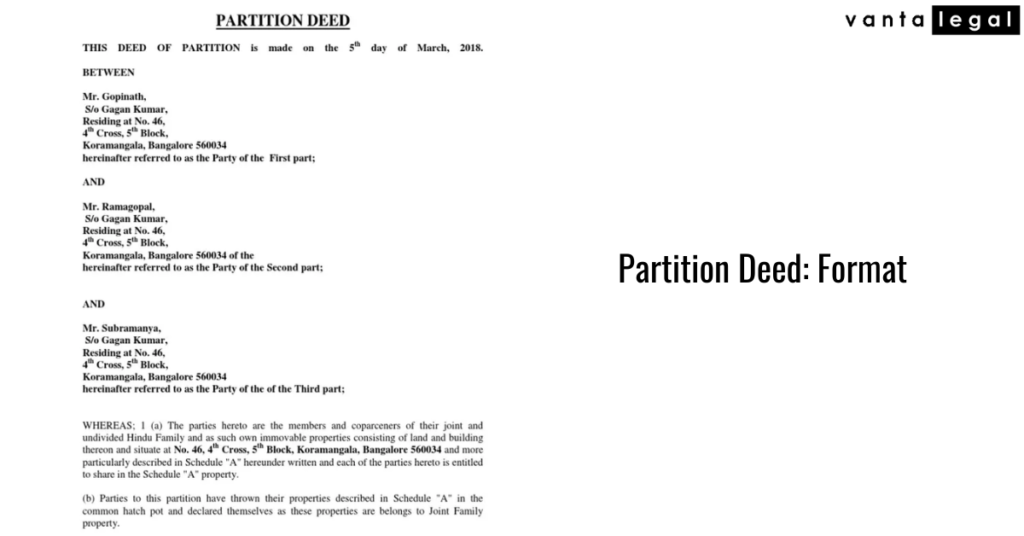
What is a Partition Deed?
A partition deed is a legal document used to divide a property among its co-owners, who may have inherited it or acquired it through other means. This deed is crucial for avoiding disputes among the owners by delineating clear, legally enforceable property shares. It formally acknowledges that the co-owners have agreed upon how the property is to be split and specifies the portions belonging to each individual.
Table of Contents
ToggleImportance of a Partition Deed
The creation of a partition deed helps in several ways:
- Legal Clarity and Certainty: It provides a clear legal definition of each co-owner’s share of the property, which can prevent disputes and misunderstandings among the parties involved.
- Ease of Sale: Co-owners may decide to sell their shares in the property. Having a partition deed makes this process smoother as each owner’s portion is clearly defined.
- Tax Implications: Proper documentation through a partition deed can help in the accurate assessment of property taxes and other fiscal obligations.
- Succession Planning: It ensures that heirs receive their rightful shares without ambiguity, thereby simplifying inheritance processes.
The Process of Creating a Partition Deed
Creating or registration process a partition deed involves several steps that need to be meticulously followed to ensure the deed’s legal validity:
- Agreement among Co-Owners: All co-owners must agree on the partition and the terms involved. This often requires negotiation and compromise.
- Valuation of Property: A professional valuation is typically necessary to determine the exact value of the property to be divided, which helps in accurately assigning shares.
- Drafting the Deed: A legal document is drafted detailing the property division, the shares assigned to each co-owner, and other relevant clauses.
- Legal Review: It is advisable to have the draft reviewed by a lawyer specializing in property law to ensure that all legal requirements are met and the language used does not leave room for disputes.
- Registration: Once finalized, the partition deed must be registered with the local government authority. This registration process involves paying the necessary stamp duty, which is based on the property’s valuation and the legal fees.
Documents Required for Partition of Land

To execute a Partition Deed effectively, several key documents are generally required. Here’s a list of the most common ones:
- Original Property Documents: This includes the title deed or any other original documents proving ownership of the property.
- Encumbrance Certificate: To show that the property is free from any legal liabilities or loans.
- Identity Proofs: Government-issued identity documents like passports, national ID cards, or driver’s licenses of all the co-owners.
- Address Proofs: Documents such as recent utility bills or bank statements to verify the addresses of the co-owners.
- Property Tax Receipts: Latest property tax receipts to prove that all dues are cleared up to date.
- Valuation Report: A report from a certified valuer stating the current market value of the property, which helps in an equitable division.
- Mutual Agreement: A written agreement signed by all parties involved, detailing the terms of the partition.
- No Objection Certificate (NOC): From relevant authorities or housing societies, if applicable, to ensure compliance with local regulations.
- Draft Partition Deed: Prepared by a legal expert, outlining how the property will be divided among the co-owners.
- Witness Details: Identification details of witnesses as required by local laws.
Key Considerations
When drafting a partition deed, several factors should be considered to ensure that the document is comprehensive and secure:
- Clear Description of Property: The deed should include a detailed description of the property, including boundaries and any other relevant details that identify the property unmistakably.
- Definition of Shares: The deed must clearly define what portion of the property each co-owner will receive.
- Management of Joint Areas: For properties with common areas such as driveways, gardens, or walls, the deed should specify how these are to be managed, including any shared responsibilities.
- Conflict Resolution: It can be beneficial to include a method for resolving disputes should they arise in the future regarding the property or the interpretation of the deed.
Want to read more of our content? Click here

